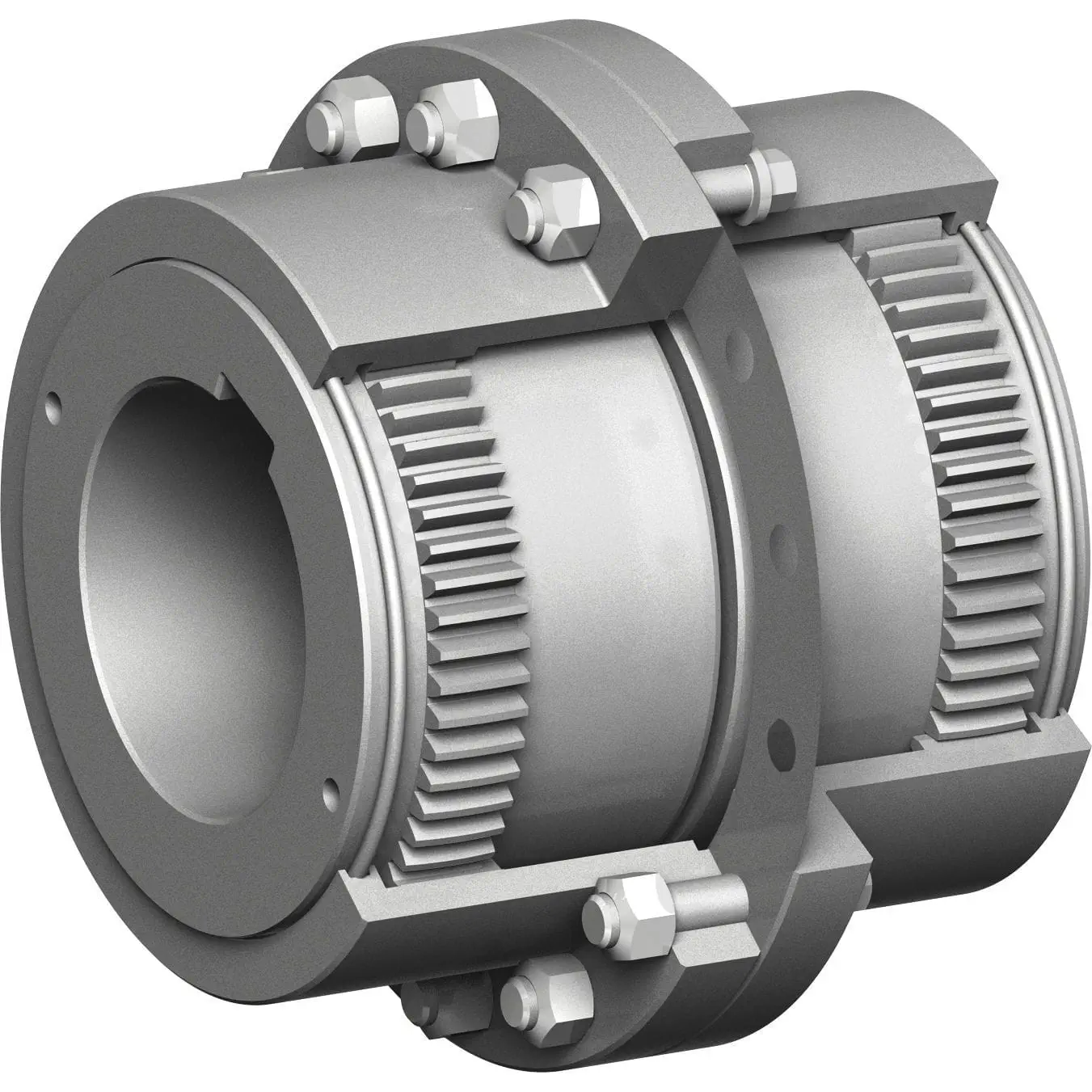Product Description
1.Small radial dimension and large bearing capacity are commonly used in shafting transmission under low speed and heavy load conditions.
2.It can compensate the relative offset of 2 axes in a certain angle and work long distance with the middle axle.
3.It is suitable for connecting horizontal 2 coaxial axes and driving shafting with a certain angle displaceme
Drum gear coupling, drum tooth is the external teeth made into a spherical, spherical center in the gear axis, side clearance than the general gear. The drum gear coupling can allow a larger angular displacement than the straight gear coupling. Moreover, the contact condition of the teeth is improved, so that the ability of transmitting torque is improved, and the service life of the coupling is prolonged. If the drum gear coupling to ensure safe and reliable work, good lubrication is essential, in exchange for slow wear. The high-speed drum-type gear coupling is mostly lubricated by lubricating oil, which needs to be filtered by high-precision oil filter, the filtrate is less than 10 microns, and the tooth surface requires continuous lubrication, otherwise the tooth surface temperature will increase and will accumulate moisture and dirt. Some high-speed drum-shaped gear couplings sometimes use the structure of oil-collecting groove hole, that is, the oil-collecting groove is processed in the outer gear shaft hole, and the oil hole which is communicated with the oil-collecting groove is drilled at the bottom of the outer gear groove, in order to make it fully lubricated, we rely on the drum-type tooth coupling high-speed operation of the centrifugal force, will be injected into the internal and external teeth mesh. Under the condition of angular displacement and stress concentration, the contact condition of the inner and outer teeth is improved by extrusion of the edge of the straight tooth, so that the friction and wear of the tooth surface are reduced and the noise is reduced. Under the same conditions, the load-carrying capacity of the drum-type gear coupling is increased by 15 -20% on average compared with the straight-type gear coupling in terms of the outer diameter of the inner gear sleeve and the maximum outer diameter of the coupling.
/* January 22, 2571 19:08:37 */!function(){function s(e,r){var a,o={};try{e&&e.split(“,”).forEach(function(e,t){e&&(a=e.match(/(.*?):(.*)$/))&&1

Misaligned Tooth Couplings: Challenges and Mitigation
Misalignment in tooth couplings can lead to various challenges that affect coupling performance and equipment reliability. Here are some challenges that can arise from misaligned tooth couplings and how they can be mitigated:
1. Increased Wear: Misalignment causes uneven loading and increased stress on the teeth of the coupling, leading to accelerated wear and potential tooth damage.
2. Reduced Efficiency: Misaligned couplings can result in energy losses due to increased friction and inefficient torque transmission.
3. Vibration and Noise: Misalignment can induce vibration and noise in the machinery system, affecting both operator comfort and equipment lifespan.
4. Premature Failure: Excessive misalignment can lead to premature coupling failure and unexpected downtime.
To mitigate these challenges, consider the following steps:
1. Proper Alignment: Ensure that the connected shafts are aligned within the specified tolerances. Use alignment tools and techniques to achieve accurate shaft alignment.
2. Regular Inspection: Perform routine inspections of the coupling to detect any signs of wear, damage, or misalignment. Address any issues promptly.
3. Lubrication: Proper lubrication reduces friction and wear, especially in misaligned conditions. Follow manufacturer guidelines for lubrication frequency and type.
4. Coupling Maintenance: Follow recommended maintenance practices provided by the coupling manufacturer to extend its lifespan and performance.
By addressing misalignment issues proactively and following proper maintenance practices, you can ensure the optimal performance and longevity of tooth couplings in your machinery systems.

Backlash in Tooth Couplings and Its Impact on Performance
Backlash is a crucial factor in tooth couplings that affects their performance. Backlash refers to the angular movement or play between the teeth of the coupling when there is a change in the direction of loading. It is the amount by which a tooth space exceeds the thickness of the engaged tooth.
The impact of backlash on performance includes:
- Positioning Accuracy: Backlash can lead to positioning inaccuracies in systems where precise motion control is required. As the direction of loading changes, the teeth need to engage before transmitting torque, causing a delay and affecting accuracy.
- Reversal Shock: In systems with frequent changes in direction, backlash can result in a sudden impact or shock when the teeth engage, leading to vibrations and potential damage to the coupling and connected components.
- System Response: Backlash can introduce a dead zone or delay in the system response when the loading direction changes. This can affect the system’s ability to respond quickly to changes in input.
- Reduced Efficiency: Backlash causes energy loss due to the need to overcome the play between teeth during direction changes. This can reduce the overall efficiency of the system.
- Wear and Fatigue: Backlash can lead to wear and fatigue of the coupling teeth and other components due to repeated impacts during loading changes.
- Noise and Vibration: The sudden engagement of teeth can generate noise and vibration, affecting the overall smoothness of operation and potentially leading to fatigue failure.
Minimizing backlash is important for improving the performance of tooth couplings. Some couplings are designed with features to reduce or compensate for backlash, while others require precise alignment and regular maintenance to manage backlash within acceptable limits.

Role of Tooth Couplings in Mechanical Systems
A tooth coupling is a type of mechanical coupling that connects two shafts to transmit torque while allowing for angular misalignment and axial movement between them. It consists of two hubs with external teeth that mesh together, engaging the teeth to transfer torque from one shaft to another. Tooth couplings are commonly used in various mechanical systems to provide a reliable and efficient means of transmitting power and motion.


editor by CX 2024-04-15
by
Tags:
Leave a Reply